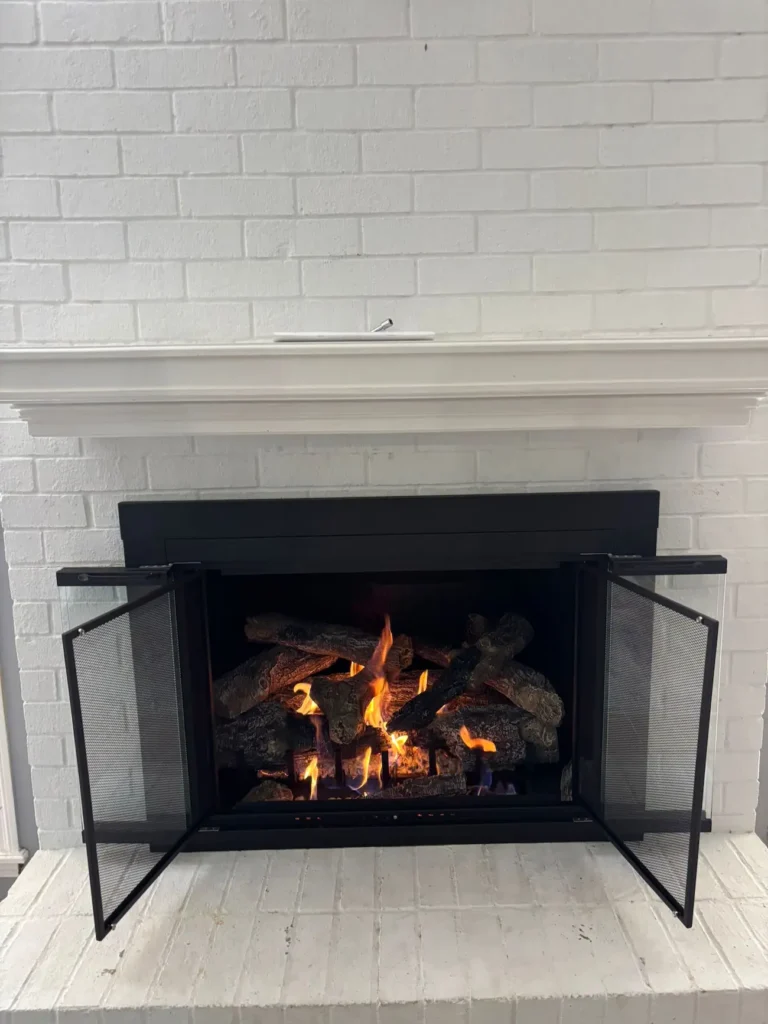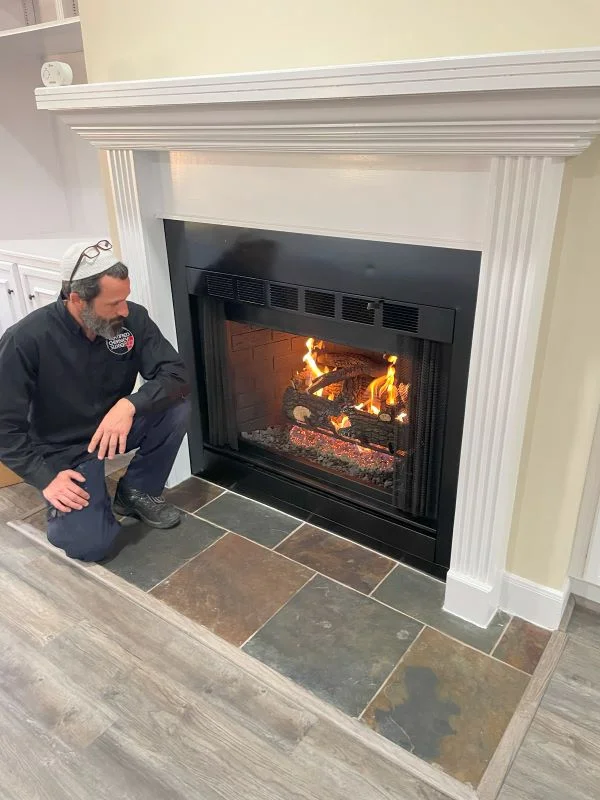Fireplaces aren’t just for cold northern states. In Texas, homeowners enjoy fireplaces for comfort, style, and even as backup heat during unexpected freezes. Over the years, many people have upgraded traditional fireplaces with modern fireplace inserts. Inserts are units placed inside an existing fireplace to make it more efficient and easy to use.
The two most common types are gas fireplace inserts and wood fireplace inserts. Each has benefits and drawbacks. The right choice depends on your lifestyle, budget, and the atmosphere you want in your home. This guide explains the pros and cons of both options to help you decide what works best for your Texas home.
What Is a Fireplace Insert?
A fireplace insert is a sealed firebox made of steel or cast iron, often with glass doors, that fits inside a masonry fireplace. Inserts improve efficiency by producing more heat and reducing energy loss. They also make fireplaces safer, since sparks and smoke are controlled. If you are starting from an older setup, our team handles full fireplace installations and can integrate an insert into a broader design refresh or code upgrade.
In Texas, inserts are popular because they provide warmth during winter nights without wasting energy. They also come in a variety of designs to match modern or traditional homes, including full fireplace remodeling projects when you want a new surround or mantel.
Gas Fireplace Inserts: Pros

One of the biggest advantages of gas inserts is convenience. With the push of a button or flip of a switch, you have instant fire. Many models come with remote controls or apps. Gas burns cleanly, leaving no ash, soot, or creosote. For busy Texas families, low maintenance is a major benefit. If you like the style of traditional logs but prefer gas, you can also consider decorative options like gas fireplaces elsewhere in the home.
Efficiency is another plus. Gas inserts convert most of the fuel into usable heat, which helps control energy costs when temperatures swing.
Gas Fireplace Inserts: Cons
- Fuel cost variability: Natural gas or propane prices can fluctuate.
- Ambience trade off: Real flames are visible, but there is no wood crackle or aroma. For a simpler aesthetic upgrade without full insert efficiency, some homeowners choose gas log sets.
- Upfront install needs: Running or extending a gas line and venting can raise costs. If your chimney needs a new liner sized for the appliance, we provide code compliant chimney relining.
Wood Fireplace Inserts: Pros
For many Texans, nothing beats a real wood fire. Wood inserts deliver authentic flames, crackling sounds, and the classic smell of burning logs. They also offer independence from utilities during outages. If you enjoy wood heat beyond the living room, standalone wood stoves are another efficient, room warming option.
In rural areas, wood can be more affordable than gas, and a well tuned insert provides solid heat for family spaces.
Another advantage is independence from utilities. A wood insert doesn’t rely on gas lines or electricity. During power outages, which can happen during storms or freezes, a wood-burning insert provides reliable heat.
Wood Fireplace Inserts: Cons
- Maintenance: Burning wood creates ash, soot, and creosote. You will need annual sweeping and periodic inspections. For multi unit or storefront properties, we also offer scheduled commercial chimney cleaning.
- Workload: Storing, hauling, and staging wood takes time.
- Air quality and efficiency: Modern wood inserts are improved, but they still require regular service to stay efficient. If your primary goal is pure convenience, gas is easier. For those who love the look, classic wood fireplaces remain a great style anchor.
Comparing the Two Options in Texas
In cities like Houston, Dallas, and Austin, gas inserts are popular for their clean, modern look and set it and forget it operation. In rural or edge suburbs, wood inserts shine thanks to lower fuel costs and off grid heat during storm related outages. Outdoor living is another big Texas trend; if you are designing a backyard entertainment space, consider durable outdoor fireplaces to complement your indoor system.
Climate also plays a role. Texas winters are generally mild, but occasional freezes can be severe. Gas inserts provide quick, reliable heat, while wood inserts are valuable during power outages. Both options can serve Texas homeowners well, depending on personal preference.
Installation and Costs
- Gas inserts: Higher upfront due to gas line work and direct venting. If your existing venting is compromised, we can address issues during chimney installation of new vent components.
- Wood inserts: Often lower initial cost, but factor in annual service. If you notice roofline staining or leaks during install season, we handle precise chimney flashing repair.
If structural work is needed around the chase or crown, our masons perform targeted chimney masonry repair, and when storm damage is severe, we can advise on broader chimney construction steps.
Maintenance Needs
- Gas: Minimal. Plan a yearly safety check and tune up. Start with a baseline Level 1 chimney inspection.
- Wood: More involved. Schedule cleanings to remove creosote, and if you notice odors or moisture, ask about our targeted seal leaky chimney service.
Any time you change appliances or fuel type, best practice is a camera backed Level 2 chimney inspection. For annual peace of mind, book a certified chimney inspection.
Safety Considerations
Both options are safer than an open fireplace, but each has unique risks:
- Gas: Must be installed to code to avoid leaks; CO detectors are recommended. If your crown or top is exposed, we can fit a tight sealing chimney cap repair and installation to reduce downdrafts and rain entry.
- Wood: Creosote accumulation is the key hazard. Routine service through our core chimney repair offerings keeps the system safe and efficient.
If your flashing was badly storm damaged, we also perform full chimney flashing replacement. For extreme cases after wind or lightning, we advise on comprehensive chimney replacement.
Extra Comfort and Whole-Home Care
Looking for a quick ambiance upgrade without a major build? A stylish refresh with electric fireplaces offers year round flame effects and zone heat. For overall indoor air quality and fire safety, it is smart to schedule companion services like air duct cleaning and routine dryer vent cleaning.
Conclusion: Which Fireplace Insert Is Best for Your Texas Home?
- Choose gas if you want convenience, efficiency, and minimal upkeep that fits a busy lifestyle.
- Choose wood if you love the classic fire experience and want reliable heat during outages with a bit more hands on care.
Both add value, warmth, and comfort to Texas homes. If you are planning a façade update or mantel change with your insert, our designers can integrate it into broader fireplace remodeling for a clean, modern look.
Gas or Wood? Find the Perfect Fireplace Insert for Your Home
Choosing between a gas and a wood fireplace insert is a big decision. We will walk you through options, venting, safety, and code so you can make the right call. Start with a comprehensive system review and annual chimney inspection plan, then pick your insert with confidence.
- Wood Inserts: Perfect for those who crave the classic crackle and authentic aroma of a real fire. Wood inserts are highly efficient, can be a great off-grid heating source during power outages, and add a rustic charm to your home. They do, however, require more maintenance and a ready supply of wood.
- Gas Inserts: The ultimate in convenience and efficiency. With a gas insert, you get instant warmth with the flip of a switch or the push of a button. They’re incredibly clean, low-maintenance, and offer precise temperature control. While they may not have the true ambiance of a wood fire, they are a practical and highly popular choice for modern Texas living.
Ready to upgrade your fireplace? Our certified experts handle design, install, and service under one roof. Explore all our chimney services and contact us for a free consultation and quote.





